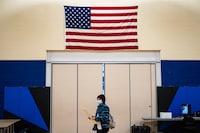Another element of Trump’s ‘rigged election’ narrative collapses

What’s important to Donald Trump is that people think that he didn’t lose the 2020 presidential election or, at the very least, that they think he only lost because someone cheated or broke the law or conspired against him or applied a curse or deployed a time machine or appealed to Odin or whatever someone might view as a remotely credible explanation for Joe Biden receiving more votes.
The important thing is the belief, not the route to the belief, like the important thing is getting out of the house that’s on fire, not that you use the proper door.
In the immediate aftermath of the election, Trump insisted that there was rampant fraud. Nefarious actors had submitted thousands or millions of ballots illegally through various mechanisms and/or the vote-counters had cheated and/or voting machines were hacked and manipulated. All of it or none of it and Trump really won, etc.
But it quickly became obvious that this didn’t happen and that the people who were insisting it did were not people that you necessarily wanted to publicly pronounce your confidence in.
So those looking to appeal to Trump supporters while keeping some distance from his nonsense created an alternative narrative: that the election had been rigged against him. That the media and social media companies had put their fingers on the scales, that rules had been changed to make it easier to vote, that outside actors poured money into the election to goose turnout. Trump embraced all these, too, given his any-door-in-a-fire approach.
Some of these assertions, like the media one, were hand-waving that had the utility of being hard to quantify. Can’t disprove vibes! Others, like the one about how rules changed, depended on the idea that it was somehow unfair to try to get more people to vote.
And then there was the one about private money going to support election administration. This one gained traction largely because it overlapped with the complaints about social media companies, complaints that themselves were built on top of years of poorly grounded rhetoric about perceived bias from places such as Facebook.
So then Facebook/Meta’s Mark Zuckerberg gives a bunch of money to an organization called Center for Tech and Civic Life (CTCL), and CTCL starts giving money to aid elections administration, generally in Democratic-voting areas, and voilà. A new narrative emerges: The election was tainted by “Zuckerbucks!”
It was always the case that this effort to draw a line from Facebook’s perceived bias through to votes was shaky. After all, 2020 was a uniquely encumbered election, given the coronavirus pandemic. Elections systems were stressed given the high interest in the election, but also because of rules oriented around combating the virus and because of the ways in which remote access to voting was expanded.
What’s more, that Democratic areas would be more frequent recipients of grants from CTCL made sense given that these were traditionally places where voting was more difficult or turnout was historically lower. And what’s the goal of backstopping elections systems if not to ensure that turnout isn’t damaged by the unique circumstances and costs that were presented in 2020?
The crux of the argument, though, was that this money led to turnout boosts that cost Trump a victory. And new research, which was compiled by data scientist Apoorva Lal and University of California Los Angeles assistant professor Daniel Thompson, suggests that it didn’t.
By comparing counties that received grants from CTCL with those that didn’t, Lal and Thompson determined that the increase in turnout in grant-receiving areas was under 0.13 percentage points — going from 60,000 voters to no more than 60,130 voters in a county where 100,000 people were registered, for example.
That’s a smaller turnout effect than was seen with a number of other changes that were or could have been implemented.
“The effect of the grants on turnout was less than half of the effect of an extra day of early voting, roughly half of the effect of a mailer encouraging citizens to vote by mail, less than one-tenth of the effect of universal vote by mail, and less than one-twentieth of the effect of mobile voting,” the researchers wrote.
Lal and Thompson also point out that more Democratic counties were more likely to apply for grants, which were then granted. They point to the factors that made election administration shakier in those places, including larger, more diverse populations.
Those counties were also harder hit in the early weeks of the pandemic. But the suggestion is that the causation offered by Trump is backward: CTCL’s bolstering Democratic-voting places was driven by the places, not CTCL (much less Zuckerberg).
Oh, they also address the other Trump argument: Counties that received grants saw increased support for Democrats somewhere between 0.02 and 0.36 percentage points. But, Lal and Thompson write, since “many counties did not receive grants, … the effect of the grants on statewide totals is substantially smaller than the effect in the average county.”
In short: “Despite the razor-thin margins in 2020, we find that the turnout and Democratic vote share effects are not large enough to have swung the election.”
Oh well. At least Trump could still blame time machines.


